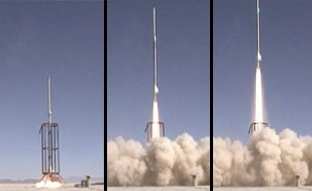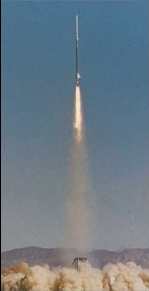Phobos EAV
The upper section (the boosted dart), was based around fibreglass tube wrapped with Kevlar, then additional fibreglass/epoxy, to form an incredibly strong composite sandwich. The dart was fitted with small carbon fibre fins at its rear, & had a solid steel nose and tail cone, to increase its weight to the simulated optimum, to maximise the altitude attained from the inertia imparted to it by the booster. The dart carried a comprehensive payload of 3 altimeter / accelerometers, a backup timer & radio tracking equipment to record and track the flight. Additionally, the booster carried an altimeter/accelerometer and a backup timer, for booster recovery system deployment.
7 MARS team members flew out to the Black Rock desert in September 2000 for the launch. On the morning of October 1st, 2000, Phobos EAV launched. The motor operated flawlessly, the rocket screamed into the skies in a matter of seconds. The booster was tracked all the way to booster apogee & successful booster recovery deployment at 27,158 feet, & the team knew from the strong radio signal being received from the dart, that the parachutes had deployed on the dart. Within half an hour, the team had driven straight out to the recovered dart. The Booster was also found a few hours later, also having recovered perfectly. Upon inspection, it was noticed that the paint had been burnt off the fins & body of the dart through heat generated by friction with the air; a sign the vehicle had achieved extremely high speeds (in fact the data from altimeter/accelerometers indicated a peak speed of 1350 miles per hour, or 600 metres per second).
The data was downloaded from the altimeters at the range head & checked by U.S. officials. On return to the UK, the data was then submitted to UKRA for verification & a new altitude record for a UK amateur rocket of 34,579 feet was verified. This figure was however, far lower than the predicted altitude, due, it is believed, to the boosted dart failing to separate from the booster precisely at motor burn out as designed, & thus losing some inertia. Despite this minor disappointment, the project as a whole was a massive success, & gained MARS & its sponsors huge media coverage.
back ← Phobos EAV Data →


